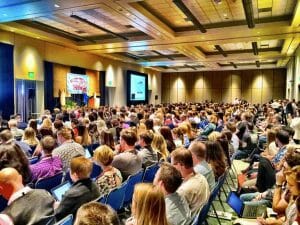5 Strategies to Uncover Event Participant Preferences
Designing a meeting or event that “hits the mark” is never a matter of chance. It’s a matter of design. To ensure participant satisfaction, every aspect of an event should be customized including content, catering, themes, decor, music, and entertainment. Uncovering event participant preferences is an important part of the event design but it is often neglected. Often, this year’s design is based on what has been done in the past.
Keeping abreast of trends, discovering “what’s hot”, and monitoring demographic data will only take you so far. To identify the preferences of participants and the target market for specific events, it’s important to ask rather than assume you know what people want.

5 Methods for Collecting Information from participants
There are a number of tried and true methods for pinpointing the preferences of a specific group. They have proven effective in marketing research yet these approaches are under-utilized in event planning:
1. Focus Groups
A guided discussion with participants from a specific demographic or target market. Focus groups are often used to collect qualitative data for designing marketing campaigns or product launches.
With Skype, GotoMeeting and other online tools, it’s easier than ever to assemble participants together for a focus group. Today, people can participate from the comfort of their homes.
Quick Tips for Using Focus Groups:
- Prepare an interview guide with the areas you want to cover.
- Ideally, focus groups should be recorded (i.e. video for in-person, audio or video for on-line).
- For face-to-face focus groups conducted, have a separate facilitator and transcriber.
- Allocate ample time to explore all areas in-depth.
- Keep them relaxed and informal.
- Go with the flow. Remember the goal is to find out what participants think, feel and expect.
- Explore areas and topics raised by participants.
2. Email Surveys
A short and targeted survey with a few questions can quickly uncover event participant preferences.
Quick Tips for Using Email Surveys:
- Remember, most people are inundated with emails.
- Keep email surveys short by focusing on no more than 6 areas.
- Use 1 question per area.
- Use multiple choice questions
- Leave ample space for surveys.
3. Event App Surveys
With current levels of email overload, surveys sent via apps in a timely way can often get through to your desired respondents with much more ease than emails.
Tips for Using App Surveys:
- In addition to using the tips for email surveys, also consult Best Practices for Gathering Feedback Using Event Apps
4. Participant Profiles
A 1 or 2 page profile completed by event participants can be of great value in tweaking event content and approaches. Include them in registration forms for conferences and send them via email to corporate event participants.
Quick Tips for Using Participant Profiles:
- Collect information about the level of experience, issues and concerns of each participant.
- Ask about each participant about their level of knowledge for each area of content you are thinking of including.
- Include a learning styles checklist with 4 – 6 questions per style.
- Collect information about meal requirements.
5. Unconference Sessions
Through this informal process at the beginning of a conference or meeting, participants have an opportunity to identify their pressing concerns and shape the agenda. The mail value they provide is ensuring that content addresses the burning concerns of participants. Sometimes these can’t be anticipated. Think 9/11, Hurricane Sandy, the volcano in Iceland, ANY natural disaster, a major election, or the laptop ban. Emerging issues will be on the top of the minds of most participants.
Quick Tips for Using Unconference Sessions:
- The quick tips for focus groups are also important for Unconference sessions.
- Begin as a whole group.
- Set the context.
- Split participants into groups with no more than 6 – 8 members.
- Re-assemble and give the groups an opportunity to report back.
- Identify topics of concern.
- Highlight those that are already covered on the agenda.
- Identify peer experts to make presentations or facilitate sessions focusing on the emerging topics.
- More info in this video …
Remember, uncovering participant preferences is only effective is you actually use the information. To ensure that you can use the information that you gather:
- Avoid a packed agenda.
- Always build some margin or “white space” into event agendas to provide an envelope of time for enriching content.
- Be transparent and let participants know how their input has shaped the content and approach.
Suggested Questions for Uncovering Event Participant Preferences
Some of the participant preferences that it is important for event and meeting planners to uncover include:
Find out: What issues or topics you need to address for the conference or meeting to be perceived as delivering value by participants.
The methods that are used to deliver content are just as important as the content. Profiling the preferred learning styles of participants will help you deliver content in a way that is easy for participants to understand and digest.
- Visual: learns by viewing colourful visuals, graphics, and videos
- Auditory: values presentations and opportunities to listen to content
- Kinaesthetic: needs to be actively engaged in learning through games, small group work, tactile stimulation
- Analytical: speakers need to include facts, figures and statistics to build credibility
- Structured: to follow content easily, presentations must have a traditional structure with a clear beginning, middle, end, and transitions
Find out: If learning games enhance or undermine the credibility of speakers. If participants get restless after sitting and listening to speakers for more than 15 minutes. If participants prefer traditional or creative delivery methods.
You can get more information about Learning Styles here: Season to Taste: Catering to Diverse Learning Styles
Music isn’t just for breaks or entertainment. Pioneering research by Bulgarian scientist Georgi Lozanov uncovered the fact that it can enhance learning. BUT, some participants find background music distracting.
Find out: Which musical genres participants prefer (classical, jazz, rock ‘n roll, country and western, heavy metal, hip-hop, rap, electronic). If participants find background music enjoyable or distracting.
Find out: What type of entertainment and socials participants prefer (e.g. sporting events, dancing, dance performances, live bands, DJs, talent contests).
Find out: Provide a checklist and give participants the opportunity to identify allergies, food sensitivities (e.g. lactose-free, gluten-free), dietary restrictions (e.g. salt-free, low-carb), special meal requests (e.g. kosher, halal, vegetarian, vegan).
